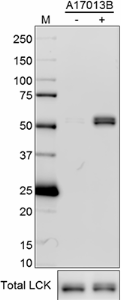- Clone
- A17013B (See other available formats)
- Regulatory Status
- RUO
- Other Names
- Leukocyte C-terminal Src kinase, Protein YT16, p56-Lck, T cell-specific protein-tyrosine kinase
- Isotype
- Mouse IgG2b, κ
- Ave. Rating
- Submit a Review
- Product Citations
- publications

-

Whole cell extracts (15 µg total protein) prepared from Jurkat cells treated with (+) or without (-) 2 mM H202 for three minutes were resolved by 4-20% Tris-Glycine gel electrophoresis, transferred to nitrocellulose, and probed with 2 µg/mL (1:250) purified anti-Lck Phospho (Tyr 505) antibody (Clone A17013B). Proteins were visualized by chemiluminescence detection using HRP goat anti-mouse-IgG. Equal Lck loading was confirmed using purified anti-Lck antibody used at 1 µg/mL (1:500 dilution).
| Cat # | Size | Price | Quantity Check Availability | Save | ||
|---|---|---|---|---|---|---|
| 684301 | 25 µg | 90€ | ||||
| 684302 | 100 µg | 212€ | ||||
The Src family tyrosine kinase p56Lck (Lck) is a non-receptor tyrosine kinase that plays a critical role in T cell selection and maturation within the thymus, and also in the function of mature T cells. Lck, which is constitutively bound to cytosolic domains of CD4 and CD8 surface receptors, plays an essential role in T cell receptor (TCR) signaling. Engagement of the TCR with peptide antigen-loaded MHC complex results in the recruitment of CD4- and CD8-bound Lck to the TCR/CD3 signaling complex. Lck then transphosphorylates TCR-gamma chains and CD3 subunits, thereby activating the TCR/CD3 signaling pathway and leading to the recruitment and subsequent phosphorylation of Zap70 by Lck. Lck also plays an important role in interleukin-2 signaling that regulates the T cell proliferative response. Phosphorylation of Lck by CSK at Tyrosine 505 negatively regulates Lck, and is proposed to generate a closed, inactive conformation of the protein.
Product DetailsProduct Details
- Verified Reactivity
- Human
- Antibody Type
- Monoclonal
- Host Species
- Mouse
- Immunogen
- Human Lck peptide phosphorylated at Tyr 505.
- Formulation
- Phosphate-buffered solution, pH 7.2, containing 0.09% sodium azide.
- Preparation
- The antibody was purified by affinity chromatography.
- Concentration
- 0.5 mg/ml
- Storage & Handling
- The antibody solution should be stored undiluted between 2°C and 8°C.
- Application
-
WB - Quality tested
- Recommended Usage
-
Each lot of this antibody is quality control tested by Western blotting. For Western blotting, the suggested use of this reagent is 0.1 - 2.0 µg per ml (1:250-1:5000 dilution). It is recommended that the reagent be titrated for optimal performance for each application.
- Application Notes
-
This clone is predicted to recognize both 58 and 61 kDa isoforms based off the presence of the immunizing epitope in both proteins. This clone may also recognize certain phosphorylated SRC tyrosine kinase family members due to high sequence similarity.
- RRID
-
AB_2716046 (BioLegend Cat. No. 684301)
AB_2716046 (BioLegend Cat. No. 684302)
Antigen Details
- Structure
- 509 and 539 amino acid isoforms with predicted molecular weights of 58 and 61 kD, respectively. Contains N-terminal domain with myristylation and palmitoylation sites, a kinase domain, and SH2 and SH3 domains that mediate protein-protein interactions bet
- Distribution
-
T cells
- Function
- T cell receptor signaling
- Interaction
- AXL, CD2, CD4, CD5, CD8, CD44, CD45, CD122, PI4K, VAV1, RASA1, FYB, CDK1, RAF1, ZAP70, SYK, RUNX3
- Cell Type
- T cells
- Biology Area
- Cell Biology, Signal Transduction
- Molecular Family
- Phospho-Proteins, Protein Kinases/Phosphatase
- Antigen References
-
1. Philipsen L, et al. 2017. Sci Signal. eaaf4736
2. Moogk D, et al. 2016. J. Immunol. 197:644.
3. Klammt C, et al. 2015. Nat. Immunol. 16:961.
4. Cancer Genome Atlas Network. 2015. Cell. 161:1681.
5. Casas J, et al. 2014. Nat. Commun. 5:5624.
6. McNeill L, et al. 2007. Immunnity. 27:425.
7. Lefebvre DC, et al. 2003. Biochem. Biophys. Acta. 1650:40.
8. Kabouridis PS. 2003. Biochem J. 371:907. - Gene ID
- 3932 View all products for this Gene ID
- UniProt
- View information about Lck Phospho Tyr505 on UniProt.org
Related Pages & Pathways
Pages
Related FAQs
Other Formats
View All Lck Phospho (Tyr505) Reagents Request Custom Conjugation| Description | Clone | Applications |
|---|---|---|
| Purified anti-Lck Phospho (Tyr505) | A17013B | WB |
Compare Data Across All Formats
This data display is provided for general comparisons between formats.
Your actual data may vary due to variations in samples, target cells, instruments and their settings, staining conditions, and other factors.
If you need assistance with selecting the best format contact our expert technical support team.
-
Purified anti-Lck Phospho (Tyr505)

Whole cell extracts (15 µg total protein) prepared from Jurk...

 Login / Register
Login / Register 







Follow Us